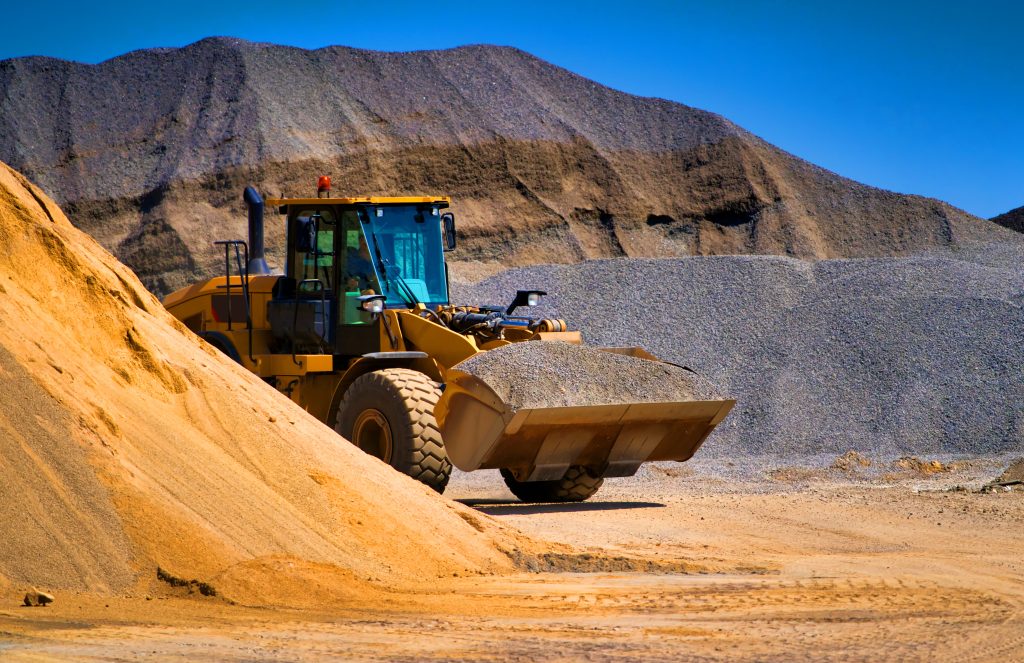The Different Types of Sands and Their Uses in Construction

Sand quarry, excavating equipment, bulldozer with heap of sand and gravel in background. Selective focus.
Sand is an important construction material. It is a key component in the production of many building materials, such as concrete, asphalt and mortar. However, not all sands have the same properties. Different types of sand used in construction have different properties and their respective uses. So, keep reading on to learn more about the types of sand used in construction.
Different Types of Sand Used in Construction and Their Uses
Here are the different types of sand used for construction and their respective uses:
River Sand
River sand is derived from riverbeds and riverbanks. It is a naturally occurring type of sand for construction uses due to its desirable properties. It possesses excellent workability and is commonly employed in concrete production, mortar mixing and plastering. Its rounded particles create smooth finishes and enhance the cohesiveness of concrete mixes. However, due to environmental concerns and restrictions on river sand mining, its availability may be limited.
Concrete Sand
Concrete sand is specifically engineered for concrete production. It is characterised by its coarse texture and uniform particle size distribution. These properties contribute to the strength and durability of concrete structures. Concrete sand is free of organic matter and clay. It ensures optimal bonding with cement for construction and minimises the risk of shrinkage cracks. It is mainly used in preparing concrete mixes for various construction applications, including foundations, slabs and pavements.
Pit Sand (Coarse Sand)
Pit sand is obtained from pits or quarries and is distinguished by its larger particle size compared to finer sands. This type of sand for construction is commonly used in projects where a coarse aggregate is required, such as in the formation of concrete blocks, road bases and backfilling. Its angular particles interlock effectively and provide stability and drainage while offering adequate support for structural elements.
M-Sand (Artificial Sand)
M-sand is short for manufactured sand. It is a finely crushed aggregate produced from hard granite stone or rocks through mechanical crushing processes. It is considered a sustainable alternative due to its reduced environmental impact and consistent quality. M-sand is extensively used in concrete production, plastering and bricklaying applications because of its superior workability and strength characteristics. Its controlled particle size distribution ensures optimal packing density and enhances the performance of construction materials.
Get expert guidance to choose the right type of sand and one of the best cement in India with JK Cement BuildXpert. Contact us today!
Fill Sand
Fill sand is a versatile sand used for construction activities. It is primarily utilised for filling voids, levelling surfaces and improving drainage in construction projects. It typically consists of a mixture of sand, gravel and clay particles. It is suitable for various applications such as backfilling trenches, landscaping and creating a stable base for pavers and retaining walls. Fill sand’s compactness and permeability make it an essential component in site preparation and earthworks for proper compaction and load distribution.
Utility Sand
Utility sand serves various purposes in construction and landscaping projects. It is characterised by its clean, well-graded composition, which makes it suitable for applications requiring good drainage and stability. Utility sand is commonly used as a base material for laying pipes, conduits and utility lines, providing a firm foundation and protecting underground infrastructure from damage.
Masonry Sand
Masonry sand is specifically formulated for masonry work and plastering applications. It features fine, uniform particles that enable smooth and consistent finishes in bricklaying, stonework and rendering projects. Masonry sand is carefully screened to remove impurities and ensure optimal compatibility with cementitious materials. Its clean and workable nature makes it an essential component in achieving professional-quality masonry workmanship.
Wrapping It Up
Choosing the right type of sand for construction is crucial for ensuring optimal performance and sustainability in construction practices. It not only affects the workability and drainage of the structure but also impacts its overall support. Therefore, it is important for builders and engineers to make informed decisions when selecting the sand to be used in construction projects.
Build with JK Cement – a trusted construction company in India. Explore our different types of cement today!
FAQs
What type of sand is used for construction?
Sand used for construction typically includes river sand, concrete sand, pit sand (coarse sand) and manufactured sand (M-sand).
What are the 4 main types of sand?
The four main types of sand used in construction are river sand, concrete sand, pit sand (coarse sand) and manufactured sand (M-sand).
What is the best quality sand for construction?
It depends on the specific requirements of the project. Generally, clean, well-graded sands with minimal impurities, suitable particle size distribution and good angularity are preferred.
What is S1 sand used for?
This type of sand for construction is commonly used for plastering, rendering and masonry work. It possesses fine particles that contribute to smooth finishes and good workability. It is preferred for achieving high-quality surface textures in construction applications.
What are S1, S2 and S3 sand?
S1, S2 and S3 sands are classification systems used to categorise sands based on their particle size distribution and suitability for specific construction purposes. S1 is fine sand, S2 is medium sand and S3 is coarse sand. These classifications help in selecting the appropriate sand for specific construction applications.